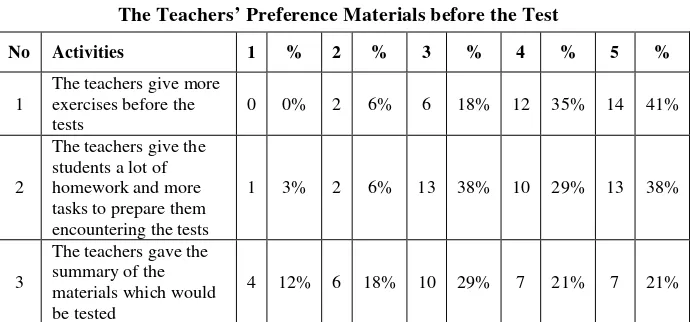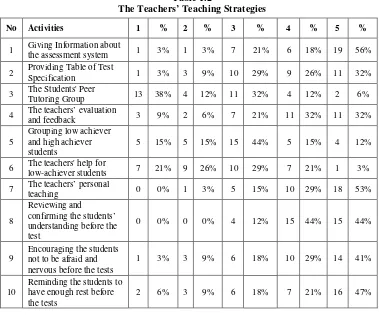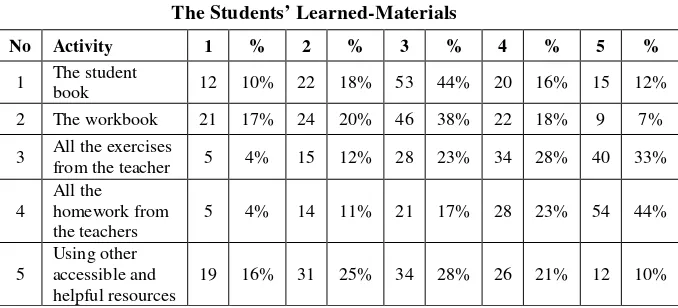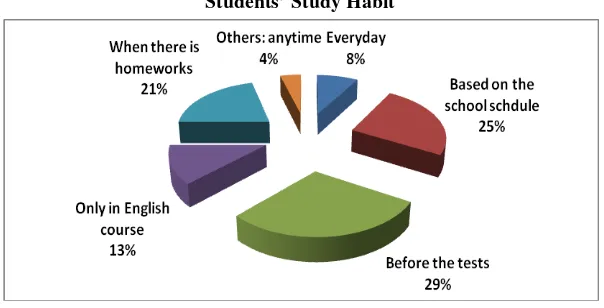WASHBACK EFFECT OF THE CLASSROOM TEST
IN JUNIOR HIGH SCHOOL
M
MaarriiaaTTiirrttaanniinnggrruumm44 A
AgguussttiinnuussNNggaaddiimmaann55
Abstract.
This study focused on the washback effects of classroom tests administered in Junior High School in Indonesian EFL contexts. To obtain the expected data two sets of questionnaires were delivered to the teachers and the students of Junior High schools in Surabaya, Indonesia. Likert scales were used to measure the obtained data. The study revealed that both teachers and students tried hard to prepare classroom tests. Passing classroom tests seemed to be the priority rather than the learning objectives themselves. Exercises for classroom test were therefore mostly given to the students. The materials learned by the students were mostly those students believed or predicted to be the materials for the tests. To some extents thus classroom tests may have both negative as well as positive effects
Key Words: Washback Effect, Classroom Tests, Necessary and Unnecessary Decisions.
Introduction
This study tried to describe the effects of classroom test on the teaching process as well as the learning process in EFL context in Indonesia. This study was done on the concept of the three-fold processes of teaching, learning and testing. Teaching-learning and testing are closely interrelated. This concept seems to provide necessary decisions in the classroom practice. Basically, the educational system has provided a concept of a continual cycle process in teaching, learning and test. The teaching is about delivering instruction and learning objectives while assessment would improve the outcomes of instruction and learning in the classroom (Reynolds, Livingstone, & Wilson, 2006). Therefore, teaching, learning and testing are connected-cycle which could influence for each other in the classroom decision.
A sufficient educational system would always have a capability to grow from time to time based on actual need and it has a parallel process with assessment program. Assessment is likely to be a bridge in educational system (Gottlieb, 2006). Assessment could connect the students’ learning objectives to the teachers’ instruction. Assessment
4
Maria Tirtaningrum aaddaallaahh Dosen Bahasa Inggris AKPER Dharma Husada Kediri.
5
Agustinus Ngadiman aaddaallaahh Dosen Program Studi Pendidikan Bahasa Inggris di FKIP
constantly gave information about the students’ improvement and achievement. On the contrary, the students’ improvement and achievement in assessment also proved the quantity of the students’ learning and the teachers’ teaching (Brown J. D., 1996). In the classroom practice, this description is reflected in how the test is delivered to the students after the teaching process.
The classroom tests are usually designed based on particular classroom decisions that are based on the teachers’ lesson plan and the school curriculum. They reflect standard and basic competencies which would be obtained by the students. Therefore, in educational system, the tests are tools of educational improvement and accountability, and also used to encourage teaching and learning process (Rudner & Schafer, 2002). Brown (2003, p. 3), has defined that test is “a method of measuring a person’s ability, knowledge, or performance in a given domain”. Likewise, Brookhart (2007, p. 5) also identified that test is “an instrument of systematic procedure for observing and describing one or more characteristic of a student using either a numerical scale or a classification scheme.” The test is needed to prove the students’ learning achievement and performance while the government and policy maker believed that the test could bring prove and change in educational program (Zhao, 2009). The tests are decided as potential way to make the students obtain the standards of educational performance (Glaser, 1987). The school system and its curriculum seem to be driven by the assessment and the test ultimately (Reynolds, Livingstone, & Wilson, 2006).
Meanwhile, Alderson and Wall (1992, p. 1) stated that “the notion of washback or backwash - the influence of tests on teaching-….” The influence of the test was asserted as a part of classroom practice when it could direct what would happen and occur in the classroom. It included the teaching aspects, such as the teaching technique, teaching contents, teaching material, teaching strategies, activity or time arrangement and the ways of assessing (Sukyadi & Mardiani, 2011). Djuric (2008) more concerned about how the classroom test was able to draw the teachers and the students near for each other, and then, the washback mechanism generated valuable meaning of the test. Thus, the whole picture of teaching, learning and testing became significant implementation of the classroom practice
the future. For example, the tests influence self-esteem, self-worth, and self-denial on attitude of the students as the test-takers. Thus, the trust on the test could harm its validity and reliability because the tests have bad influence toward the test takers. They also influence the students as test-takers. In this study, as mentioned previously, several tests could affect attitude, behavior and motivation of teachers, students, and parents. Generally, the tests signify the students performance, and the content objectives of the study, as quoted from Khaniya (1990, p.26). Thus, the washback certainly existed when the tests were conducted in the classroom practice.
Nevertheless, the test is still needed in the educational program not only to inform the students’ achievement, but also to transform the students’ attitude and competence (Berliner & Rosenshine, 1987). The test is not deniable at the end. Therefore, the role of washback is required to estimate and ensure that the test gave appropriate influence to teaching and learning in the classroom decision or in the educational system generally (Cheng & Curtis, 2004). In fact, the research on wahsback is determined as empirical study because it is related to the actual experiences and activities of the teachers and the students in the classroom. Pizarro (2010) describes that washback studies is to connect the teachers’ and the students’ responses toward the high-stakes examination. That phenomenon was exploited for the benefit of teaching process and learning activities. The particular context of classroom practice promoted and exposed several kinds of actions because of the EFL classroom tests.
The Data
The data were obtained from the questionnaires distributed to 121 grade 7-8 students and 34 English teachers from random private school in Surabaya. The questionnaire was adapted from Brown’s questionnaires for the students’ strategies for success in taking a test. (2002, p. 67). This questionnaire was designed to find information about what students did as test-takers, before, during and after the test and what teachers do before, during and after classroom tests. Likert scales were used to measure what teachers and students did in preparing classroom tests.
The Results
1. The Effect of Classroom Test on Teaching Process
1.1. The Teaching Materials Delivered Before the Test.
As summarized in table 1 below the materials dilivred by the teachers before classroom test were (a) exercise, (b) homework and (c) summary for the exam
Table 1.1
The Teachers’ Preference Materials before the Test
No Activities 1 % 2 % 3 % 4 % 5 %
1
The teachers give more exercises before the tests
0 0% 2 6% 6 18% 12 35% 14 41%
2
The teachers give the students a lot of homework and more tasks to prepare them encountering the tests
1 3% 2 6% 13 38% 10 29% 13 38%
3
The teachers gave the summary of the materials which would be tested
4 12% 6 18% 10 29% 7 21% 7 21%
The table shows that 41% of the teachers always and 35% often gave more exercises for the students before the tests. Then, the teachers also provided homework to support their teaching content are showed 33% each of the teachers always and sometimes gave their students homework. Homework obliged the students to learn the tested-materials from the teachers. The last material which was preferred by the teachers for preparing the students is the summary of all materials. It states that not all of the teachers used to summarize their materials for helping their students study. It shows more than 18% of the teachers made summary of their materials to help the students. The summary of materials helps the students study easier than study the textbook one by one. This summary also guides the students certain materials which might appear in the classroom test.
1.2. Teaching Strategies to prepare the Classroom Test.
44% of the teachers both always and often review and ensure their students understanding all materials before the test. 41% of the teachers encouraged their students not to be afraid or nervous before the tests; and, 47% of the teachers reminded the students to have enough rest before having the tests. All these preferences were decided by the teachers to prepare the students before the test.
Table 1.2
The Teachers’ Teaching Strategies
No Activities 1 % 2 % 3 % 4 % 5 %
1 Giving Information about
the assessment system 1 3% 1 3% 7 21% 6 18% 19 56%
2 Providing Table of Test
Specification 1 3% 3 9% 10 29% 9 26% 11 32%
3 The Students' Peer
Tutoring Group 13 38% 4 12% 11 32% 4 12% 2 6%
4 The teachers’ evaluation
and feedback 3 9% 2 6% 7 21% 11 32% 11 32%
7 The teachers’ personal
teaching 0 0% 1 3% 5 15% 10 29% 18 53% nervous before the tests
1 3% 3 9% 6 18% 10 29% 14 41%
10
Reminding the students to have enough rest before the tests
2 6% 3 9% 6 18% 7 21% 16 47%
1.3. The Teachers’ Plan for Test Design
Table 1.3
The Teachers’ Process in Test Design
No Activities 1 % 2 % 3 % 4 % 5 %
1
The main guideline for classroom test design: same as the exercises
0 0% 1 3% 2 6% 12 35% 19 56%
2. The Effect of Classroom Test on Learning Activity
2.1. Learned Materials before the Test
2.2. The Students’ Strategies
The study also revealed several efforts taken by the students before the test. Their responses, as shown in Table 2.2 bring about strategies which were able to encourage the students’ confidence in test-taking,; 35% of the students sometimes reviewed all materials from the teacher; 43% of the students always reviewed the materials from the previous exercises; 29% of students never learned the provided exercises; 34% of the students sometimes asked their friends when they found difficulties; 37% of the students decided to study with their friends; only 26% of the students decided to consult their respective teachers and, 28% of the students who often consulted their course teachers
Table 2.2
The Students’ Strategies in Test-Taking Preparation
2.3. The Students’ Activities before the Test
Chart 2.3.1 below reveals that 29% of the students studied only when they had a test. Only 8% of the students had a good studying habit. 21% of them did their home works and 13% of them took courses outside the school.
Chart 2.3.1 Students’ Study Habit
However, as summarized in Chart 2.2 the students’ learning habit and activities before the test were not well-organized and prepared. Most of the students only learned only to pass classroom tests. Only few were able to manage their study and used it to promote learning and skills
Chart 2.3.2
The Students' Activities before the Test
2.4 Students’ Levels of Anxiety
of the students sometimes felt confused, and 48% of the student felt nothing.
Table 2.3
The Students’ Level of Anxiety
Usually, the level of anxiety draws them to obtain certain response, such as: cheating. In the interview, some of them admitted cheating because they were afraid of getting bad mark. The following Table 2.4 shows that students’ decision to have back up plan before the test.
Table 2.4
The Students’ Back-up Plans
No Activity 1 % 2 % 3 % 4 % 5 %
1 The students plan
to cheat 73 60% 25 20% 16 13% 4 3% 4 3%
2
The students try to find any leak information about the tests
97 80% 9 7% 8 7% 4 3% 4 3%
As seen in Table 2.4, some of the students decided unusual activities before the test, cheating and trying to find any leak information about the tests. 16% of the students sometimes cheated and not more than 9% of the students try to find leak information before the test. It seems that the teachers and parents need to have concern to these few students.
Discussions
1. Washback Effect of Classroom Test on Teaching Process
Alderson and Wall (1992), and Brown (2002) suggest teachers [1] encourage students to study and preview the lessons which are going to be tested thoroughly, [2] teaching to skill, cognitive domain, and practice, [3] enhance certain activity, motivation and well-prepared to study, and [4] create relax and confident situation for their students before the tests. The present study found that teachers were likely to obtain only few, such as encouraging the students and enhancing certain activity and motivation, even though they were focused on the tests. They did not apply what Anderson, Wall and Brown have suggested. What teachers
No Activity 1 % 2 % 3 % 4 % 5 %
1 Feeling
Nervous 9 7% 22 18% 38 31% 27 22% 27 22%
2 Cannot Sleep 55 45% 20 16% 13 11% 13 11% 21 17%
3 Feeling Panic 35 29% 15 12% 30 25% 20 16% 22 18%
4 Feeling
Confused 70 57% 10 8% 24 20% 4 3% 14 11%
5 Feeling
mostly did was just test coaching. Shohamy (2001) called this practice as “deterioration” of test validity and learning process.
Many teachers, however, are still aware of the functions of classroom test. classroom tests are used to promote learning. They realized that students do not study if there is not test.
2. Washback Effect of Classroom Test on Learning Activities.
This study revealed that most students did not prepare their classroom tests seriously. They still did not know what to do. From the results of the research, the students’ strategies and study habit focused on test survival and score achievement. Some of them did not apply the appropriate strategies as Alderson and Wall (1992), and Brown (2002) suggested, [1] Studying and reviewing the lessons thoroughly, [2] doing the homework and exercise diligently, [3] performing learning target (skill and cognitive domain) as usual process despite approaching the tests, [4] enhancing certain activity and motivation in study. Nevertheless, this study revealed that the students’ preparation for the tests was sufficiently achieved. Only few strategies were considered weakening the real learning because they focused in test survival and the score achievement.
Consequently, the students did not obtain the learning outcomes as stated in the curriculum, syllabus and the lesson plan. They tended to practice all kinds of tests instruction and made the state of learning as their tactics to encounter the tests. In the interview, they admitted that the result of the tests became the main evidence of high-stakes status students. Most of the people, like Shohamy (2001, p. 9) said, they turned into “blind trust in tests score as valid predictions and indications of the students’ performance.”
Moreover, the finding of this study also indicated that some of the students had no effort to achieve genuine learning outcomes and as a result they chose to cheat. This was unnecessary decisions of the students to solve their problem. Even though only few chose to cheat, it signified negative value of the test influence.
The study also uncovered students’ learning habits. They learned only they knew the classroom tests approaching. They learned only the part of materials. They focused to pass the tests. Their learning need is low. The students learned for the test. They learned trick for test and attained to pass the tests. The focus is only on the test score achievement.
Classroom tests, however, still have some positive effects, Because of classroom tests, students are encouraged to learn. Thus classroom tests always promote learning.
Conclusion
materials are those for exam preparation, such as exam exercises. Classroom tests may also have negative effects to the students learning practice; most students only study for the exam, they study hard only when they will have classroom tests, even some of them try to cheat. However, to some other extent, classroom tests also may have positive effects. Because of classroom tests, students tried hard to master the materials. The teachers also try hard to make the students learn and master the teaching materials by selecting various teaching strategies and summarizing teaching materials and rehearsing the materials already provided.
Bibliography
Alderson, J. C., & Wall, D. (1992, February). Does Washback Exist? Retrieved November 10, 2012
Berliner, D. C., & Rosenshine, B. V. (Eds.). (1987). Talks to Teachers. New York, USA.
Brookhart, S. M., & Nitko, A. J. (2007). Assessment and Grading in Classrooms. New Jersey: Pearson Merrii Prentice Hall.
Brown, H. D. (2003). Language Assessment: Principles and Classroom Practices. San Francisco, CA.: Longman Inc.
Brown, H. D. (2002). Strategies for Success: A Practical Guide to Learning English. San Francisco: Longman.
Brown, J. D. (1996). Testing in Language Programs. New Jersey: Prentice Hall Regents.
Cheng, L., & Curtis, A. (2004). Washback or Backwash: A Review of the Impact of Testing on Teaching and Learning. In Washback in Language Testing: Research Contexts and Methods (pp. 3-17). London: Lawrence Erlbaum Associates Publishers.
Djuric, M. (2008). Dealing with Situations of Positive and Negative Washback. Scripta Manent 4(1) , pp. 14-27.
Glaser, R. (1987). The Integration of Instruction and Testing: Implications from the Study of Human Cognition. In D. C. Berliner, & B. V. Rosenshine (Eds.), Talks to Teachers (pp. 329-341). New York: Random House.
Gottlieb, M. (2006). Assessing English Language Learning. Thousand Oak, California: Corwin Press A Sage Publications COmpany.
Research Synthesis Group. London: Evidence for Policy and Practice Information and Co-ordinating Centre.
McMillan, J. H. (2008). Educational Research: Fundamentals for the Consumer. Boston: Pearson.
Pizarro, M. A. (2010). Exploring the WashbackEffects of a High-Stakes English Test on the Teaching of English in Spanish Upper Secondary Schools. Revista Alicantina de Estudios Ingleses 23 , pp. 149-170.
Reynolds, C. R., Livingstone, R. B., & Wilson, V. (2006). Measurement and Assessment in Education. Boston: Pearson Education Inc.
Rudner, L. M., & Schafer, W. D. (2002). What Teachers Need to Know about Assessment. Washington DC: National Education Association.
Shohamy, E. (2001). The Power of Tests: A Critical Perspective on the Uses of Language Tests. Harlow, England: Longman Pearson Education.
Sukyadi, D., & Mardiani, R. (2011, June). The Washback Effect of English National Examination (ENE) on English Teachers Classroom Teaching and Students' Learning. Retrieved September 22, 2012, from K@ta, Vol. 13, no. 1: http://webcache.googleusercontent.com/search?q=cache:http://pusl it2.petra.ac.id/ejournal/index.php/ing/article/view/18214&hl=en&p rmd=imvns&strip=1
Suskie, L. (2008). Understanding the Nature and Purpose of Assessment. In J. E. Spurlin, S. A. Rajala, & J. L. Lavelle, Designing Better Engineering Education Through Assessment (pp. 3-17). Sterling, Virginia: Stylus Publishing, LLC.





